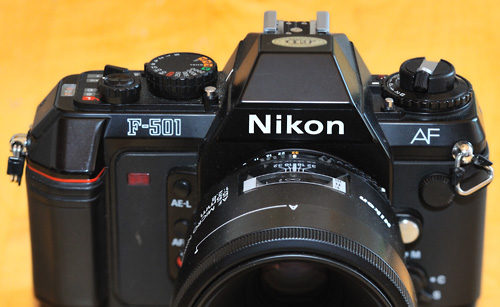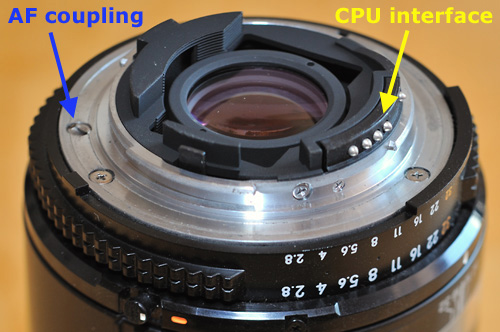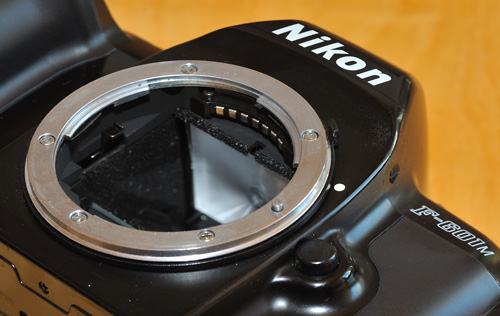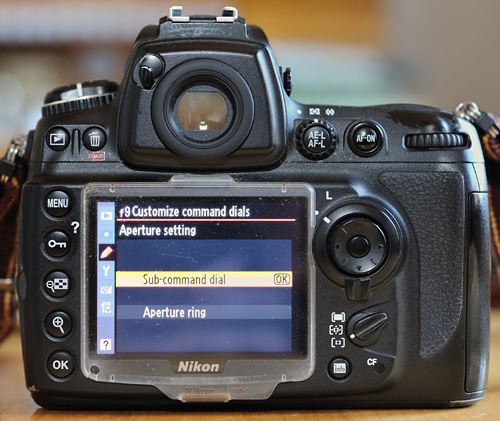

|
|
New era: Nikon F-501 with a first generation screwdriver AF lens (AF Micro-Nikkor 55mm f/2.8). |

|
|
Mount of the AF Micro-Nikkor 55mm f/2.8. |
In 1986 Nikon introduced the F501 (in US: N2020). That was the beginning of a new era, along with the camera they introduced a couple of AF lenses, too. But in contrast to Minolta and Canon, Nikon didn't introduce a new lens mount. The F-501 works fine with older lenses and the AF lenses behave like AI-S lenses on older bodies. Great!
The AF-lenses have two additional coupling elements over an AI-S lens:
For about two years these two elements were ever combined. But in 1988 Nikon announced the Nikkor 500mm f/4 P. That was an MF lens with a CPU interface (I guess Nikon had problems to integrate a screwdriver AF in such a long and heavy lens, the AF-I lenses were introduced four years later). It was the first AI-P lens.
An AI-P lens is an AI-S lens with an additional CPU interface. For further information about AI-S lenses you should read the article the difference between an AI-S and an AI lens first. In conjunction with cameras without CPU interface an AI-P lens behaves like an AI-S lens.
The CPU in the lens allows the camera to read out lens data such as focal length, speed and smallest aperture. For a typical prime lens the values are static. In contrast, for a zoom lens or for a Micro-Nikkor they can vary depending on the current focal length or the current distance. In my opinion it is a little bit overstated to call the chip a CPU. By the way: the camera "knows" that a CPU lens has a linear aperture lever, allowing the camera to control the aperture.
In conjunction with an F-501 an AI-P lens has no advantages over an AI-S type. The reason why is that the F-501 has inherited all the mechanical coupling elements from the F-301. But for every other camera with CPU interface an AI-P lens has advantages. The practical value of the advantages depends on the specific camera in use. Overall you can divide the cameras with CPU interface into two groups:

|
|
Curiosity: The only Nikon MF body with CPU interface. The F-601M (in US: N6000) was announced in 1989. It has both a CPU interface and an AI coupling. Therefore some people call this model 'AI-P camera'. If you are working on film this is still a real fine camera body. Today, you can get it for nearly nothing! |

|
|
Mount of the Nikkor 45mm f/2.8 P, silver version. |
In conjunction with a camera with CPU interface only, a non-CPU lens only offers manual mode. Moreover, exposure metering is not available. In contrast an AI-P lens is fully compatible and allows you everything, of course except for autofocus. That is a really huge advantage!
On the more expensive models with both AI and CPU interface you can use the M and A modes with a non-CPU lens. Some of these cameras offer matrix metering, too. That's true especially for the last DSLRs of this group, such as the D2, D3, D4, D200, D300, D700, D800 and D7000, if you have keyed in the lens data. With an AI-P lens you definitely have matrix metering, you can use the S and P modes and you can control the aperture over the camera's command dials.
Well, that is not that easy. Simply because Nikon has only built three AI-P lenses ever! The first one was the above mentioned 500mm f/4 P. Then there came the 16kg super zoom 1200-1700mm f5.6-8 P and the 45mm f/2.8 P. The last one is the only one of these three that I have tried. It is a pancake lens, introduced together with the FM3a. For my fingers it was way too small!
But there are a lot of third party lenses with an AI-P mount on the market, for example Zeiss ZF.2 lenses, Voigtländer SL II lenses or Samyang lenses with Nikon (AE) mount.
For many AI-S lenses a conversion to an AI-P lens is possible by adding a CPU. But Nikon itself doesn't offer such a service. See my 'links' section for repair shops offering a CPU conversion. Maybe, you can do it yourself, too. The chips are offered e.g. on ebay and DIY instructions for a few lenses can be found on the Web.
Take into account that the chip of such a conversion only contains static data. For example for a zoom lens only one focal length can be programmed. But for a prime lens there is no difference to a real AI-P lens.
You can also find a lot of reports about the "chipping" of older (meaning pre-AI-S) lenses. Be careful! The result is a lens interface that Nikon has never designed! The existence of a CPU signals the camera that the aperture of the lens works linearly. But on a pre-AI-S lens it doesn't work linearly.
In conjunction with cameras with a CPU interface only, it results in faulty exposures. The degree of this fault is not constant but depends on the combination of lens and particular aperture. If you use the lens non-chipped, you can only use the M mode with no metering. But if you set the lens' aperture ring to F11, it is F11. With the same lens chipped, you must set the aperture via the camera's control dial. If you set it to F11, it will probably not be F11! Of course, if you shoot RAW, you are able to correct the exposure a bit in post-processing. But I recommend to buy another camera (with AI coupling)!
On a camera with both CPU interface and AI coupling you can use even non-chipped lenses in A and M mode. As mentioned above, on the newer DSLRs (e.g. D2, D3, D4, D200, D300, D700, D800) you also have matrix metering, if you key in the lens data. The aperture must be set on the lens' aperture ring, meaning what you get is what you set! You still have two drawbacks (in my eyes minor ones):

|
|
Customising option for controlling the aperture, here shown on a D700. |
For many years of using Nikon cameras in the past I had to set the aperture via the aperture ring of the lens. The aperture rings of different lenses differs in size and feel. Therefore I really love today's usual method of setting the aperture via one of the command dials - it is the same feeling with every lens.
If you use a G type lens without an aperture ring, you must control the aperture from the camera. With a non-CPU lens you must set the aperture on the lens. For lenses with both, a CPU interface and an aperture ring (the majority of the lenses I use daily), the modern DSLRs have a customizing option: You can decide either to use a command dial of the camera or to use the lens' aperture ring. Of course, I have set my bodies to 'command dial'.
If you use a chipped pre-AI-S lens and you want to work exactly, you must use the aperture ring. Because it is now a lens with CPU and aperture ring, the customizing option of the camera must be set to 'aperture ring'. For me, that is a serious drawback and a reason for not using CPU-converted pre-AI-S lenses!